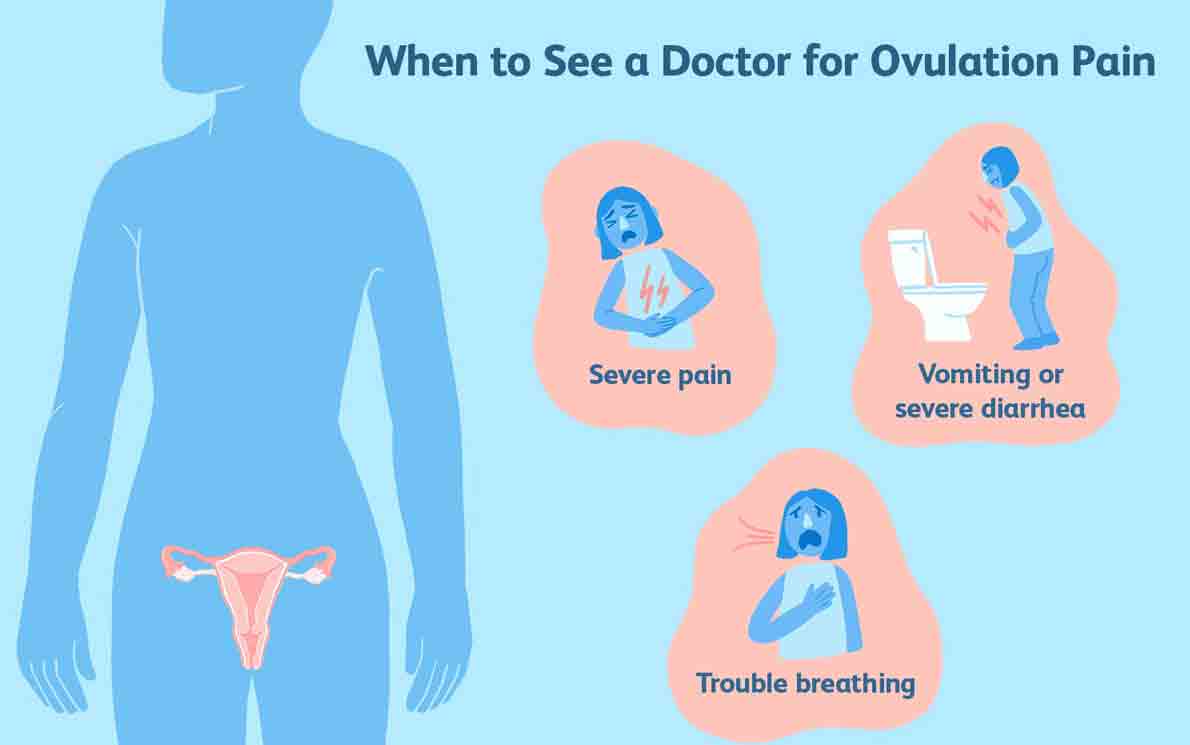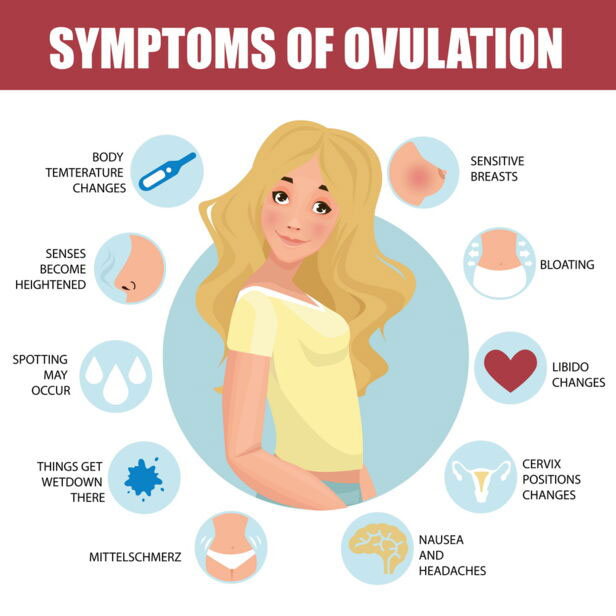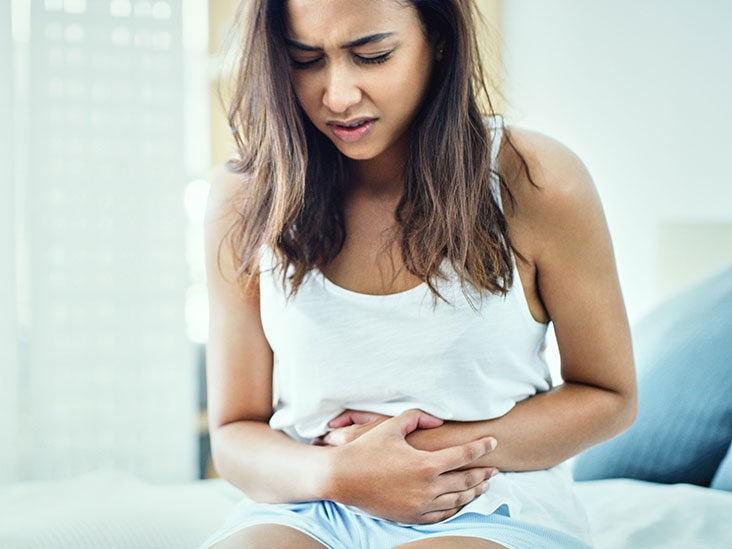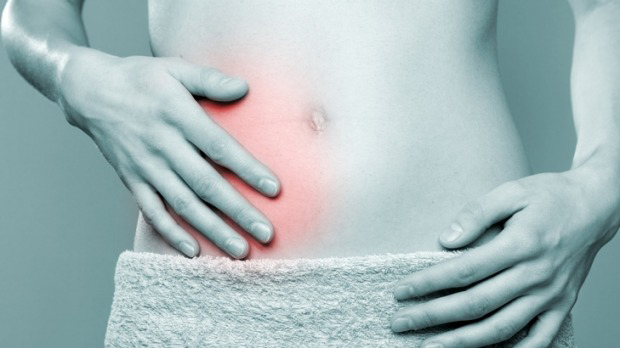WHAT IS OVULATION PAIN?
Mittelschmerz or ovulation pain, felt during ovulation in the pelvic or abdomen region. Ovulation is part of the menstrual cycle when an ovary releases an egg causing pelvic pain. The ovulation pain ranges from mild twinge to severe discomfort lasting from minutes to hours.
Ovulation pain is very common, affecting more than 40% of women who ovulate during their reproductive years, and it can affect them almost every month.
Women feel pain in their lower abdomen, the middle part of the abdomen, or the side of the abdomen where the ovary is releasing the egg. The fallopian tube tightens after the release of the egg. This helps the egg reach a sperm for fertilization. The ruptured follicle produces blood and other fluids. These would enter the abdominal cavity causing pain or irritation.
Many women never experience pain during ovulation. Other women undergo mid cycle pain every other month. Ovulation pain may feel like period pain.

WHAT CAUSES OVULATION PAIN?
The development of the egg in the ovary is surrounded by follicular fluid. During the ovulation process the egg and the fluid along with some blood, are released from the ovary. Although the exact cause of mittelschmerz is unknown. It is believed that the fluid or blood irritate the lining of the abdominal cavity, causing pain. The pain reduces after the egg is released or the body absorbs the fluid or blood.
Hormones induce the ovaries to produce approximately 20 follicles. This follicle contains an immature egg (ovum). Only one follicle survives to maturity and the membrane of the follicles expands causing pain.
Pain might be due to a ruptured follicle. The follicle might burst causing bleeding. Blood along with fluid from the ruptured follicle irritate the lining of the abdomen. This causes pain. This is part of the normal menstrual cycle.
Other possible reason for ovulation pain is:
- Before the release of an egg with ovulation, follicle growth stretches the surface of your ovary.
- Ruptured follicle irritates the lining of your abdomen (peritoneum) and blood or fluid is released.
- Ovulation pain is harmless in most cases. Severe and prolonged ovulation pain can be a symptom of underlying medical conditions such as:
- Salpingitis – inflammation of the fallopian tubes due to infection
- Chronic pelvic inflammatory disease
- Endometriosis – Growth in the lining of the endometrium or womb
- Ovarian cyst – an abnormal growth of cells in ovary filled with fluid
- Ectopic pregnancy – a pregnancy outside of the womb such as in fallopian tubes. This causes cramping, abdominal pain and vaginal
- bleeding.
- Appendicitis
- Gastrointestinal problems

WHAT ARE THE SYMPTOMS OF OVULATION PAIN?
Ovulation pain ranges from a severe discomfort to a little twinge. The primary symptom of ovulation is pain on one side of the abdomen, and the pain can last from a few minutes to a few hours. Main characteristics of ovulation pain are:
- Pain and/or cramping on one side of the abdomen
- Pain during the menstrual cycle.
- Pain shifts from one side to the other every month.
- Sharp severe discomfort
Vaginal bleeding or abnormal uterine bleeding : It lasts approximately five days and occurs every 21 to 35 days. This can be due to hormone changes, cancer or early pregnancy.
Vaginal discharge: It is a clear or whitish fluid that comes out of the vagina. It is normal, most women have vaginal discharge but not all discharge is normal. Changes in the amount, color, or smell could indicate an infection.
Nausea: Nausea might also be a symptom if the pain is severe. It might also be a symptom of other conditions such as early pregnancy.
- Breast tenderness
- Increased libido
- Hot flushes
- Mood swings
- Increased basal body temperature
- Insomnia
HOW TO DIAGNOSE OVULATION PAIN?
Doctor would recommend tests to determine whether ovulation pain is harmless or caused by infection or disease may include:
- Medical history
- Physical examination, such as internal pelvic examination
- Blood tests
- Cervical cultures
- Abdominal ultrasound
- Vaginal ultrasound
- Exploratory surgery such as laparoscopic or ‘keyhole’ surgery

WHAT ARE THE DISORDERS RELATED TO OVULATION PAIN?
Many disorders are the reason behind ovulation pain, including:
- Hypothalamic dysfunction – This occurs from disrupted levels of FSH and LH hormones. These hormones are responsible for ovulation. This occurs from emotional stress, excessive workout, a high or low bodyweight, or weight loss or weight gain. Tumors in the hypothalamus also cause the dysfunction.
- Premature ovarian insufficiency – It is a condition estrogen levels drop, resulting in the premature disruption of egg production. It mainly affects women before the age of 40. It might be the effect of environmental stressors, autoimmune diseases or genetic abnormalities.
- Hyperprolactinemia or excess prolactin – Large amounts of prolactin is produced, especially if you are taking specific types of medication or have some sort of gland abnormality. This condition causes a decrease in the level of estrogen production. This disorder rarely causes ovarian dysfunction.
HOW IS OVULATION PAIN TREATED?
Most women don’t require treatments for ovulation pain because it regularly goes away within a day. Some basic home remedies help in case of pain such as:
- Over-the-counter medicine, such as ibuprofen.
- Non-steroidal anti-inflammatory medication to help with the pain.
- Hormonal contraceptives to stop ovulation from happening.
- Taking a hot bath.
- Using a heating pad.
If you are suffering from severe ovulation pain, it is better to consult a healthcare provider about taking birth control. Birth control pills might help as hormonal birth control medications prevent ovulation. Thus preventing pregnancy, which effectively stop ovulation pain.

WHEN TO TALK TO A HEALTHCARE PROVIDER?
If you have missed your last menstrual period it is better to call the healthcare provider. You should contact your doctor if you have these symptoms during ovulation:
- A fever greater than 100.4 degrees Fahrenheit.
- Pain while urinating
- Red or burning skin at the site of pain
- Severe nausea or vomiting
- Severe pain in the middle of the menstrual cycle and might last longer than a day or occurs during most months
- Over-the-counter pain medication does not relieve the pain.
- Vomiting
- Heavy vaginal bleeding between periods.
WHAT IS WOMEN’S OUTLOOK ON OVULATION PAIN?
Ovulation pain is normal. It’s considered one of the side effects of having a period. It’s neither dangerous, nor a sign of a serious health condition. Ovulation pain doesn’t affect fertility. It might help you be more aware of when you ovulate. Conception chances are high if a couple have sex in the days before, during and after ovulation. Some women rely on ovulation pain to help them plan a pregnancy.
If you or anyone you know is suffering from ovulation pain, our expert providers at Specialty Care Clinics will take care of your health and help you recover.
Call us on (469) 545-9983 to book an telehealth appointment with our specialists.
